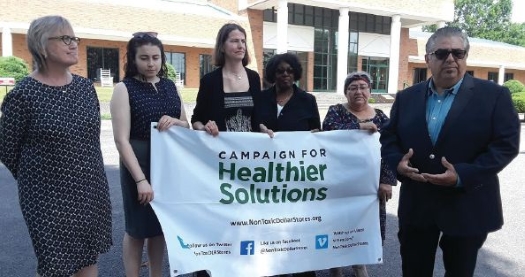Report shows companies improve toxic safety score
By J.S. Adams, Contributing Writer | Last updated: Dec 4, 2019 - 11:03:19 AMWhat's your opinion on this article?
As environmentalists pressure the chemical industry and the Trump Administration to protect consumers from toxins, a new report shows that some retailers have made efforts to improve their safety score.

Supporters of the Campaign for Healthier Solutions.
|
The fourth annual “Who’s Minding the Store?” report, released by the Safer Chemicals Healthy Families’ Mind the Store campaign, evaluated 43 retailers with 190,000 stores across North America. It also focused on dollar stores.
“For five years, the Campaign for Healthier Solutions has been calling on dollar stores to protect our children’s health and eliminate any toxic chemicals that may be in products and food they sell, and finally, some are beginning to listen,” said Jose Bravo in a press release, coordinator of the Campaign for Healthier Solutions.
The report says 63 percent of the evaluated companies have improved their safety score over the past year. The average score has moved from a D+ to a B-.
In 2017, Dollar Tree made a vow to remove 17 toxic chemicals from their products by 2020. Many are found in children’s products. Mike Schade, director of the Mind the Store Campaign, said these chemicals impact poorer communities.
“Low-income communities and communities of color are disproportionately exposed to toxic chemicals that can be harmful to their health,” Mr. Schade said. “This is especially true for frontline communities where chemicals are manufactured at chemical plants and when they’re disposed of in landfills and incinerators.”
Since the 2008 recession, dollar stores have flourished in the United States. According to a CNN article titled, “Dollar stores are everywhere,” that’s a problem for poor Americans. Some experts believe that dollar stores intentionally cluster in low-income neighborhoods, which keeps healthy food stores from coming in, the article stated.
“A growing body of science has linked exposure to toxic chemicals to health problems and diseases,” said Mr. Schade. “These include cancer, learning and developmental disabilities, and reproductive harm. These health effects are so widespread that many doctors and scientists refer to this as a ‘silent epidemic,’” he added.
These aren’t just industry issues. Policies from the Trump administration have affected their impact. Mr. Schade said the federal government is putting the chemical industry in charge of government programs that are supposed to protect the public from toxic chemicals.
In 2016, the Obama administration amended the Toxic Substances Control Act of 1976 (TSCA). This law gave the Environmental Protection Agency the ability to ensure that chemicals put in everyday products were safe for consumers. In June, five democratic senators sent a letter to the EPA, claiming that the Trump administration favored the chemical industry over the health of Americans.
“The EPA has weakened or delayed action on hazardous chemicals that can cause cancer, reproductive harm, and other serious illnesses,” said Mr. Schade. “And the U.S. Food and Drug Administration, operating under a 60-year-old law on food additives, has failed to use modern science to assess the safety of thousands of toxic chemicals used in food packaging.”
With the efforts of environmental organizations, many stores have removed toxic chemicals from their products. Leading the pack is Apple, Target, Walmart and Ikea. The most improved are Bed Bath & Beyond, Dollar General, Lowe’s, Panera Bread, Sephora, and Staples.
The public can use the report to help them choose companies to shop from.
“For those evaluated companies that are lagging behind the other evaluated retailers, leverage the power of the purse and join us in raising your voice to call for urgent reform,” said Mr. Schade.
“It is more important than ever for retailers to leverage their market power and influence to drive hazardous chemicals out of consumer products, packaging, and global supply chains.”
INSIDE STORIES AND REVIEWS
-
-
About Harriett ... and the Negro Hollywood Road Show
By Rabiah Muhammad, Guest Columnist » Full Story -
Skepticism greets Jay-Z, NFL talk of inspiring change
By Bryan 18X Crawford and Richard B. Muhammad The Final Call Newspaper @TheFinalCall » Full Story -
The painful problem of Black girls and suicide
By Charlene Muhammad -National Correspondent- » Full Story -
Exploitation of Innocence - Report: Perceptions, policies hurting Black girls
By Charlene Muhammad -National Correspondent- » Full Story -
Big Ballin: Big ideas fuel a father’s Big Baller Brand and brash business sense
By Bryan Crawford -Contributing Writer- » Full Story






 Click Here Stay Connected!
Click Here Stay Connected!








